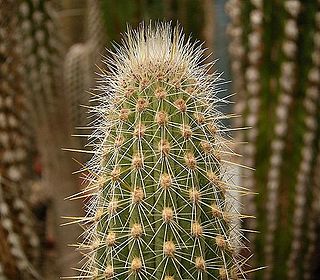
Gymnocalycium, commonly called chin cactus, is a genus of about 70 South American species of cactus. The genus name Gymnocalycium refers to the flower buds bearing no hair or spines.

Echinocereus is a genus of ribbed, usually small to medium-sized, cylindrical shaped cacti, comprising about 70 species native to the southern United States and Mexico in very sunny, rocky places. Usually the flowers are large and the fruit edible.

Neoraimondia is a genus of medium to large cacti from Peru. The genus is named after the Italian-born Peruvian explorer, naturalist, and scientist, Antonio Raimondi.

Cochemiea macdougallii is a species of cactus in the genus Cochemiea.

Pediocactus is a genus of cacti. The genus comprises between 6 and 11 species, depending upon the authority. Species of this genus are referred to as hedgehog cacti, though that name is also applied to plants from the genera Echinocereus and Echinopsis. Species may also be referred to as pincushion cacti, a common name which is also applied to other genera.

Pelecyphora, pincushion cactus or foxtail cactus is a genus of cacti, comprising 20 species. They originate from Mexico and the United States.

Uebelmannia is genus of cacti, native to southeast Brazil.

Weberocereus is genus of cacti. It produces a green and white flower and is found mainly in Costa Rica and Nicaragua.

Copiapoa is a genus of flowering plants in the cactus family Cactaceae, from the dry coastal deserts, particularly the Atacama Desert, of northern Chile.

Eriosyce is a genus of cacti native to Chile.

Parodia is a genus of flowering plants in the family Cactaceae, native to the eastern slopes of the Andes in northwestern Argentina and southwestern Bolivia and in the lowland pampas regions of northeastern Argentina, southern Brazil, eastern Paraguay, and Uruguay. This genus has about 65 species, many of which have been transferred from Eriocactus, Notocactus and Wigginsia. They range from small globose plants to 1 m (3 ft) tall columnar cacti. All are deeply ribbed and spiny, with single flowers at or near the crown. Some species produce offsets at the base. They are popular in cultivation, but must be grown indoors where temperatures fall below 10 °C (50 °F).

Arthrocereus is a genus of cactus, native to southeast and west-central Brazil.

Discocactus is a genus of tropical cacti. Discocactus plants are endemic to southern Brazil, eastern Bolivia, and northern Paraguay. These species are in the risk of extinction in the wild.

Haageocereus is a genus of cacti endemic to the lower elevations of the extremely dry desert along the coast of Peru and northern Chile.

Oreocereus is a genus of cacti, known only from high altitudes of the Andes. Its name means "mountain cereus", formed from the Greek prefix oreo- and the Neo-Latin cereus, meaning wax or torch.

Oroya is a genus of cacti, native to Peru. The genus is widespread in the Peruvian Andes.

Weberbauerocereus is a genus of ceroid cactus, considered to be intermediate between the genera Trichocereus and Cleistocactus. The genus is named after Augusto Weberbauer because of his extensive research in the Peruvian Andes. The genus is native to Bolivia and Peru.

Lophocereus marginatus is a species of plant in the family Cactaceae. It is sometimes called Mexican fencepost cactus.

Soehrensia thelegona is a species of cactus in the Soehrensia genus.

Thelocactus macdowellii, called the Chihuahuan snowball, is a species of cactus native to northeastern Mexico. It has gained the Royal Horticultural Society's Award of Garden Merit.






















